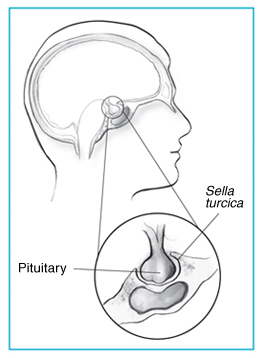Sella turcica
| Sella turcica | |
|---|---|
 Sella turcica shown in red | |
| Details | |
| Part of | Sphenoid bone |
| System | Skeletal system |
| Identifiers | |
| TA98 | Lua error in Module:Wikidata at line 746: attempt to index field 'wikibase' (a nil value). |
| TH | {{#property:P1694}} |
| TE | {{#property:P1693}} |
| FMA | {{#property:P1402}} |
| Anatomical terminology [[[d:Lua error in Module:Wikidata at line 865: attempt to index field 'wikibase' (a nil value).|edit on Wikidata]]] | |
The sella turcica (Latin for "Turkish saddle") is a saddle-shaped depression in the body of the sphenoid bone of the human skull. It is located in the middle cranial fossa, a central depression in the floor of the cranial cavity. The sella turcica is an important anatomical landmark because it houses the pituitary gland.
Anatomy[edit | edit source]
The sella turcica is bounded by the tuberculum sellae anteriorly and the dorsum sellae posteriorly. The hypophyseal fossa, the deepest part of the sella turcica, contains the pituitary gland. The sella turcica is covered by a dural fold called the diaphragma sellae, which has an opening for the passage of the pituitary stalk.
Function[edit | edit source]
The primary function of the sella turcica is to protect and support the pituitary gland. The pituitary gland, also known as the hypophysis, is a crucial endocrine gland that regulates various physiological processes through the secretion of hormones.
Clinical significance[edit | edit source]
Abnormalities in the size or shape of the sella turcica can be indicative of various medical conditions. For example, an enlarged sella turcica may be associated with a pituitary adenoma, a benign tumor of the pituitary gland. Other conditions that can affect the sella turcica include empty sella syndrome, where the sella turcica appears empty on imaging due to the flattening of the pituitary gland, and craniopharyngioma, a type of brain tumor that can affect the region.
Imaging[edit | edit source]
The sella turcica can be visualized using various imaging techniques, including X-ray, computed tomography (CT), and magnetic resonance imaging (MRI). These imaging modalities are essential for diagnosing abnormalities of the pituitary gland and surrounding structures.
See also[edit | edit source]
References[edit | edit source]
Navigation: Wellness - Encyclopedia - Health topics - Disease Index - Drugs - World Directory - Gray's Anatomy - Keto diet - Recipes
Search WikiMD
Ad.Tired of being Overweight? Try W8MD's physician weight loss program.
Semaglutide (Ozempic / Wegovy and Tirzepatide (Mounjaro / Zepbound) available.
Advertise on WikiMD
WikiMD is not a substitute for professional medical advice. See full disclaimer.
Credits:Most images are courtesy of Wikimedia commons, and templates Wikipedia, licensed under CC BY SA or similar.Contributors: Prab R. Tumpati, MD






